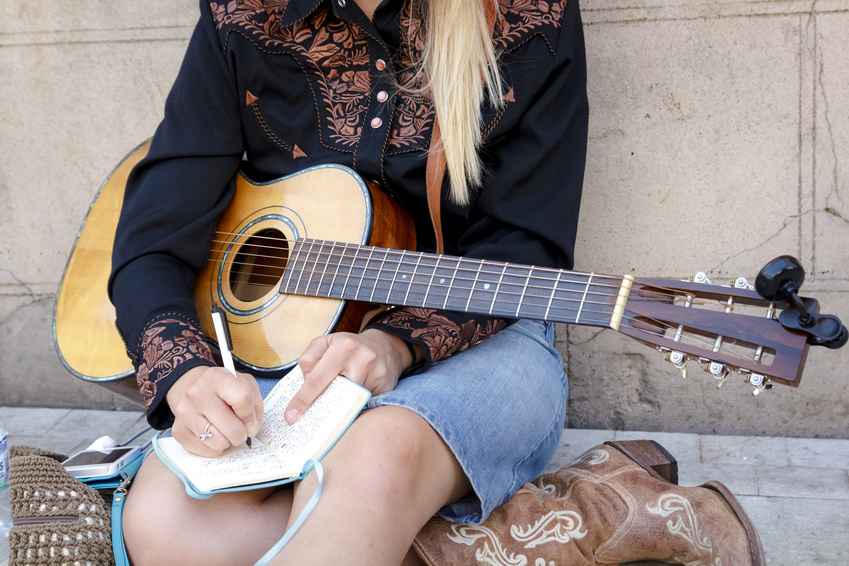As many musicians, performers, and songwriters know, the copyrights in their works are crucial to their success. It is important to know who the author or authors of those works are, and the various rights and benefits that come with authorship.
If you wrote and recorded a song, you are the sole author of that song and the sound recording. As the owner of those copyrights, you can reap the full benefits of the rights they grant. However, this becomes complicated when more than one author is involved in the creation of the work, or if you are using previously published works—such as sampling a beat or repurposing poetry as lyrics—when creating your original work.
Becoming an Author
A copyright is created when a work is “fixed in a tangible medium,” including composition paper, recordings, computer files, and the like. Ownership vests in the author or authors of that original work.
Let’s say, Anna, a lyrist writes a poem. Ben, a composer, writes music. When those elements are combined to create a song, the authorship and thus ownership of the song’s copyright depends on several factors: 1) when the poem or music was created, 2) Anna and Ben’s intentions when the song was created, and 3) whether either party had acquired the rights to use the other’s work.
For example, if Ben is inspired by Anna’s poem and obtains the rights to create the song, Ben is the author and holds the copyright to the song—but not Anna’s poem itself. Based on their licensing agreement, he may owe Anna royalty payments for her lyrics—but Anna is neither an author nor a copyright holder of the song. Ben can also obtain a copyright for the music he created (song without lyrics), for which he’d be the sole author. This allows him to license the music to another lyrist to create new lyrics without consideration to Anna.
As another example, Anna and Ben may have created their respective contributions with the intent of making the song. In this case, they are joint authors of the work and joint owners of the copyright to the song, including its individual parts (music and lyrics). This means, absent a separate agreement, both have the right to license the use of the work to others, whether in whole or in part.
Recording the song creates another layer of copyright. Sound recordings contain at least two copyrights: one for the recording, and the other for the song itself. If Ben and his friend Cat record the song he and Anna wrote, Ben and Cat are joint authors of the song’s sound recording, while Ben and Anna retain rights to the intellectual property of the song. Cat, however, is not an author nor holds any rights to the song, and Anna doesn’t own any rights to the sound recording. But Ben is an author of and has rights in both copyrights: song and sound recording.
Benefits of Being an Author
Copyrights give authors certain exclusive rights, such as the right to reproduce and distribute the work. The public performance right, though, is treated differently. Only the authors of the song—in the above example, Anna and Ben—receive the right to publicly perform it.
This means that, when the song is played in public—on the radio, by a cover band, etc.—only Anna and Ben get paid, even if Cat was the recording artist who made it popular. In 1995, Congress took steps to partially fix this issue, giving sound recording authors digital performance rights. Now, when the song is played on Spotify or Pandora, authors of that sound recording get paid.
With this new provision, Anna, Ben, and Cat would all make money if the sound recording is played on Spotify. However, since it is also considered a public performance of the song, Ben gets paid twice.
There are various other rights for authors and those who wish to use others’ copyrights, including the right to create derivative works and the mechanical right to cover another author’s music.
Many artists assign their copyrights to publishers or engage agents, lawyers, or other organizations to help manage their rights and collect royalties that are owed. These organizations include the American Society of Composers, Authors, and Publishers (ASCAP) for public performance rights, Sound Exchange for digital performance, and the Harry Fox Agency for mechanical rights.
Issues Authors May Face
Problems arise when multiple authors of multiple copyrights don’t know exactly what they own—or when they think they own a part of a work that they don’t. For example, your drummer may become very disgruntled if he learns he is not going to receive any royalties from the band’s #1 radio hit because he was not the author of the song.
Issues may also arise if an artist is considered an employee and creates a work within the scope of that employment, in which case the authorship and copyright ownership vests in the employer. An even more complicated situation arises when one hires another to create a “work-for-hire” product. This is can be a very complex process that, if not done correctly, may not result in authorship, ownership, or rights vesting in the person paying for the work.
Therefore, artists must recognize when they are an author and the rights that come along with it, as well as who else may or may not claim authorship or ownership in that copyright.
Many of these issues can be addressed through agreements or other written assignments, so that there is a clear understanding and equitable distribution of income between all contributors, regardless of actual authorship. If you plan to create works with others, use others’ works to create your own, or want to license your works to others, consider seeking professional guidance to ensure that you obtain all the rights afforded to you—and benefit financially from your creative efforts. Carl Wilson, of the Law Office of William C. Wilson, is happy to provide this information.





